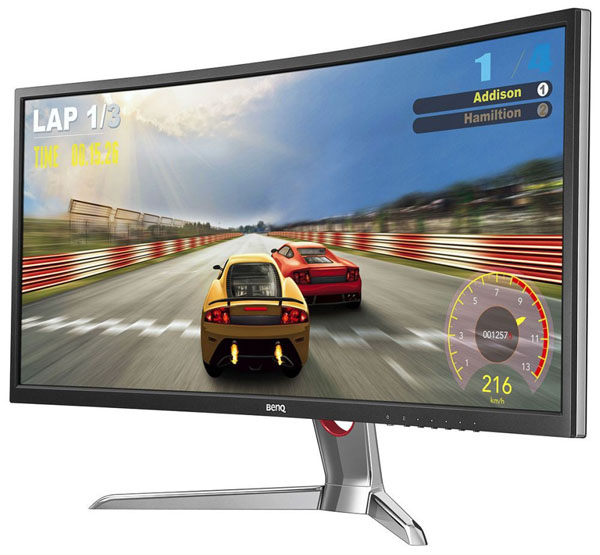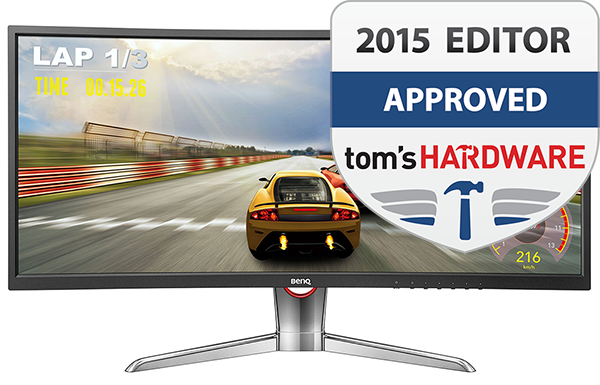BenQ XR3501 35-Inch Curved Monitor Review
BenQ's XR3051 high-contrast AMVA panel offers an impressive 2000R curvature and a 144Hz refresh rate along with some very unique attributes.
Why you can trust Tom's Hardware
Conclusion
Now that all the testing and game-playing is over, have we decided on the value quotient of the XR3501? We'd have to say it's a tough call.
On the positive side, the contrast of XR3501's AMVA panel is undeniably excellent. It doesn't just have a little better contrast than the rest, it's way better. Doubling contrast at the same max output level means black levels are half-again lower. The difference between .2 and .1cd/m2 is very obvious to see. That translates into much greater depth and realism. Once you've played Far Cry 4 on a display like this, going back to a 1000:1 screen is something of a letdown.
You also get stable 144Hz operation without having to settle for a TN monitor. Refresh rates in the IPS camp have been slow to rise above 60Hz and even though image quality can be quite good with TN, IPS and its different flavors are still better thanks to their larger viewing sweet spot and more consistent gamma and screen uniformity.
The XR3501 also does very well in the color department. The default Standard picture mode offers fair performance and can easily be improved upon by switching to the sRGB preset. Once you calibrate however, all image parameters come close to professional levels. There is no shortage of bright saturated color here and thanks to great gamma and grayscale tracking, it's accurate as well.
Then there's that unique curve. Plenty of users are still asking why curved screens exist at all. And we agree they're not for everyone. Even if their prices were to suddenly drop, we doubt users would flock to them. And we were skeptical at first too, but once we tried a few, our opinion changed. It's not as if a curved screen is now a requirement for gaming enjoyment, but it sure is cool! We've enjoyed playing on every curved example we've had in the lab so far and the XR3501 is our favorite at the moment.
For strictly business tasks, we'd have to choose the 3800R curve for its non-existent distortion. The 2000R spec introduces a visible pincushion shape to on-screen windows though it has no ill effects on text. However, when editing photos, watching movies or playing games, the tighter radius covers more of the user's peripheral vision and does a better job of de-emphasizing the surrounding environment.
The decision has to come down to what you place greater importance on. If you must have G-Sync or FreeSync, the discussion is over -- go for another display. If resolution is a factor, the XR3501 offers only 1080p; but again, we'd urge you check one out in the flesh before deciding as the extra contrast might just change your mind. And don't forget that pushing fewer pixels means you can rock out high framerates with a sub-$300 video card.
Get Tom's Hardware's best news and in-depth reviews, straight to your inbox.
In the end, BenQ's XR3501 presents something of a conundrum. It has some truly unique features that enhance image quality and gameplay, but it leaves a couple of things out and it doesn't come cheap. With monitors like Acer's XB270HU, which offers G-Sync, IPS and QHD resolution for $200 less, BenQ's new screen is facing some stiff competition. Still, its picture quality is well beyond most of the TN gaming screens out there.
If you're already a fan of the curve, you'll love this screen. And if you don't need frame-rate-matching, it serves up a fantastic image. Our recommendation: decide what features are most important to you and check one out in the flesh before pulling the trigger.
There's no denying the XR3501's superb image quality, solid build and excellent performance. For those reasons we're giving it our Tom's Editor Approved Award.
MORE: Best Monitors
MORE: All Monitor Content
Follow Tom's Hardware on Twitter, Facebook and Google+.
Current page: Conclusion
Prev Page Viewing Angles, Uniformity, Response, Lag And Gameplay
Christian Eberle is a Contributing Editor for Tom's Hardware US. He's a veteran reviewer of A/V equipment, specializing in monitors. Christian began his obsession with tech when he built his first PC in 1991, a 286 running DOS 3.0 at a blazing 12MHz. In 2006, he undertook training from the Imaging Science Foundation in video calibration and testing and thus started a passion for precise imaging that persists to this day. He is also a professional musician with a degree from the New England Conservatory as a classical bassoonist which he used to good effect as a performer with the West Point Army Band from 1987 to 2013. He enjoys watching movies and listening to high-end audio in his custom-built home theater and can be seen riding trails near his home on a race-ready ICE VTX recumbent trike. Christian enjoys the endless summer in Florida where he lives with his wife and Chihuahua and plays with orchestras around the state.
-
Soul_keeper Everytime I see these display news/reviews I look for the power usage numbers and end up having to google for them.Reply
Can you start adding the power usage to the specs tables ?
thanks -
iam2thecrowe ReplyEverytime I see these display news/reviews I look for the power usage numbers and end up having to google for them.
I don't know, I have never looked at power usage specs when deciding which monitor to buy. Ever. It is expensive for only 1080 vertical pixels though. Would rather settle for a 60hz model with 1440 for a similar price.
Can you start adding the power usage to the specs tables ?
thanks -
rajeshgoblet 'The other curved displays we've seen sport a 3800R curvature, which means a radius of 3000 millimeters.' i think its a little bit typo. 3000 should be 3800 milimeters.Reply -
Shankovich Seems pretty good. Don't mean to sound like a whiner but for $1000 I would expect 10 bit colour on it. Then again loving that 144 Hz, can't complain about anything else really.Reply -
Realist9 1080p at 35 inches. No. 5 years ago? Maybe. Today? No.Reply
And someone dropping $1000 on their monitor is very unlikely to have a sub $300 video card.
No excuses. This should have been at least 1440p. I was excited until I saw that. -
eklipz330 this is clearly an attempt at milking the market. next year they will have a 1440p variant, and the year after they will finally incorporate freesync/gsync.Reply
they could have at least made it 1200p

